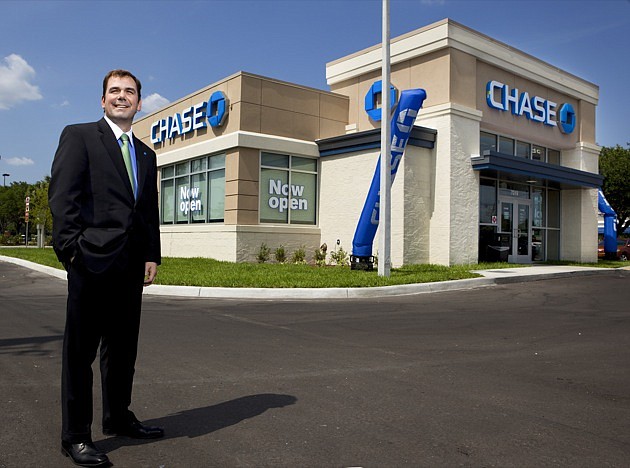When JPMorgan Chase & Co. started scouting locations for new Chase branches on the Gulf Coast, a Sonic drive-in restaurant floated to the top of its list.
Good traffic access, high visibility, and the right square footage made it a prime pick for the bank's expansion effort.
The property, purchased earlier this year, is an example of Chase Bank's real estate ambitions as it looks to buy or build 37 new branch locations in Florida by the end of 2011.
Most banks aren't in a hurry to take on more real estate, but rather than acquire assets of failed banks, Chase is expanding by finding the right locations for future and existing bank branch sites in Florida. It has budgeted $100 million for that purpose this year alone.
That figure is expected to grow significantly as Chase expects to keep buying at an aggressive rate for at least the next four years with a healthy piece of that spending set to occur along the west coast of Florida.
So far, Chase has planned five new branches this year in Hillsborough County, three in Manatee, two each in Sarasota and Pinellas and one in Pasco.
Except for its brokerage and credit card business, Chase hasn't had much of a direct presence in the state until three years ago. In fact, for decades Chase only had a total of six branches in the state.
That changed in September 2008, when the bank bought the deposits and branches of Washington Mutual at an FDIC sale for $1.9 billion. The purchase gave Chase more than 250 branches in Florida.
For Jeremy Young, Chase's senior vice president and market manager for Central Florida, the expansion is ambitious but also typical of the way the bank has grown in the past.
“This is the strategy that has worked for us for years,” Young says. “After buying Washington Mutual, we believe we can fill in organically.”
Young compares the bank's expansion plans for Florida and California to its expansion in the Chicago area from 2002 to 2004 and in the New York area after its purchase of The Bank of New York in 2006.
While WaMu's branches offered the bank a quick entrance to the state, many of them were less than ideal in both customer traffic and visibility.
“All but a handful were in in-line shopping centers, and poorly positioned at that,” says Charles Alloway, an associate with CB Richard Ellis in Tampa, who is brokering a Clearwater land lease with Chase. “WaMu had a different corporate culture.”
Chase is relocating a number of those former WaMu branches, officials say, but the current expansion figures are new branches in addition to those needed branch moves.
To capture the population densities and locations it wants, the bank has in many cases chosen to develop new branches, sometimes eschewing existing branch buildings in favor of retail sites.
“We go into an area assuming we will be developing all new buildings,” says Nancy Norris, a JPMorgan Chase & Co. spokeswoman. “We are very particular. We need to find locations with shopping nearby and easy access. But we won't choose a second-class site.”
To this end, the bank purchased a restaurant building in Naples' Pine Ridge Crossing Shopping Center in addition to a former Sonic drive-in restaurant on State Road 64 in Bradenton. Alloway is representing the landlord of a Clearwater fast food restaurant location the bank is considering redeveloping.
“It's the economy that makes it much more feasible,” Young says. “We already had a large number of customers in Florida with relationships with us [through its parent's credit and wealth-management businesses]; we just needed branches there to invite them to do other business with us. We know what we like and what we don't like. We'd rather build from the ground up than inherit someone else's problems.”
Along with avoiding typical real estate problems, choosing not to pursue failed bank assets from the FDIC can offer the bank a great level of financial safety.
“When you are buying a bank you're taking a risk with their loan portfolio,” says banking analyst Benjamin Bishop Jr., chairman of Allen C. Ewing & Co. in Jacksonville. “You're also getting [the site and building] for 50 cents on the dollar.”
Tramm Hudson, the newest market president for Stearns Bank, agrees with Chase's decision to expand with more prominent locations. He says history has consistently shown that retail branch convenience drives a bank's business.
“Everyone is trying to increase their cross-sales ratio (the percentage of customer's business at a bank), and to grow that you need freestanding branches,” he says. “That's the main reason people choose a bank.”
Hudson says in the '80s he saw this first hand as one of his bank branches grew its transactions 50% just by moving to a more prominent building with a drive-thru.
A big reason that Chase is able to expand comes from the health of its parent company's balance sheet. As of May 10, JPMorgan Chase & Co. had $822.82 billion in cash on hand, greater than most of the world's largest financial firms. In the first quarter, it was the most profitable financial firm with $5.14 billion in net income, better than Wells Fargo, Citigroup and Bank of America Corp. The company reported $102.69 billion for all of 2010.
“We have the capital; that's what sets us apart from other financial firms both large and small,” says Norris. “That gives us the wherewithal to grow the way we feel is smartest.”
For Chase that extra cash will translate into an addition of 375 to 500 new branches in Florida by 2015, up from 280 currently.
Norris says that each new location costs the bank between $4 and $6 million in development costs. The bank estimates it will be adding more than 100 positions along with its branches on the Gulf Coast this year and a total of 400 statewide.
A big unknown factor in Chase's expansion is its timing. Many observers, Alloway included, expect it to be a mixed bag, with lower real estate acquisition costs and fewer small competitors because of the recession, balanced against more entrenched large competition from the likes of SunTrust and Wachovia/Wells Fargo. They may get a better site for less money, Alloway says, but there are fewer available.
But Hudson thinks the timing is right and that they have the wherewithal to establish themselves as a major player in the state in fairly short order.
“Florida banking customers have been shell-shocked by the banking turnovers,” Tramm says. “It's obvious [Chase is] flexing their muscles and that they will be a bank to contend with as time goes forward.”
Gulf Coast Chase expansion sites
Hillsborough County
• Countryway in Westchase, Tampa
• Dale Mabry Highway and Neptune Street, Tampa
• Waters Avenue and Hanley Road Tampa
• Two opening in 2011
Pinellas County
• Two opening late 2011
Pasco County
• U.S. 19 and Marine, New Port Richey
Manatee County
• Lakewood Ranch and State Road 70, Bradenton
• Two opening late 2011
Sarasota County
• U.S. 41 and Jacaranda Boulevard, Venice
• One opening late 2011






